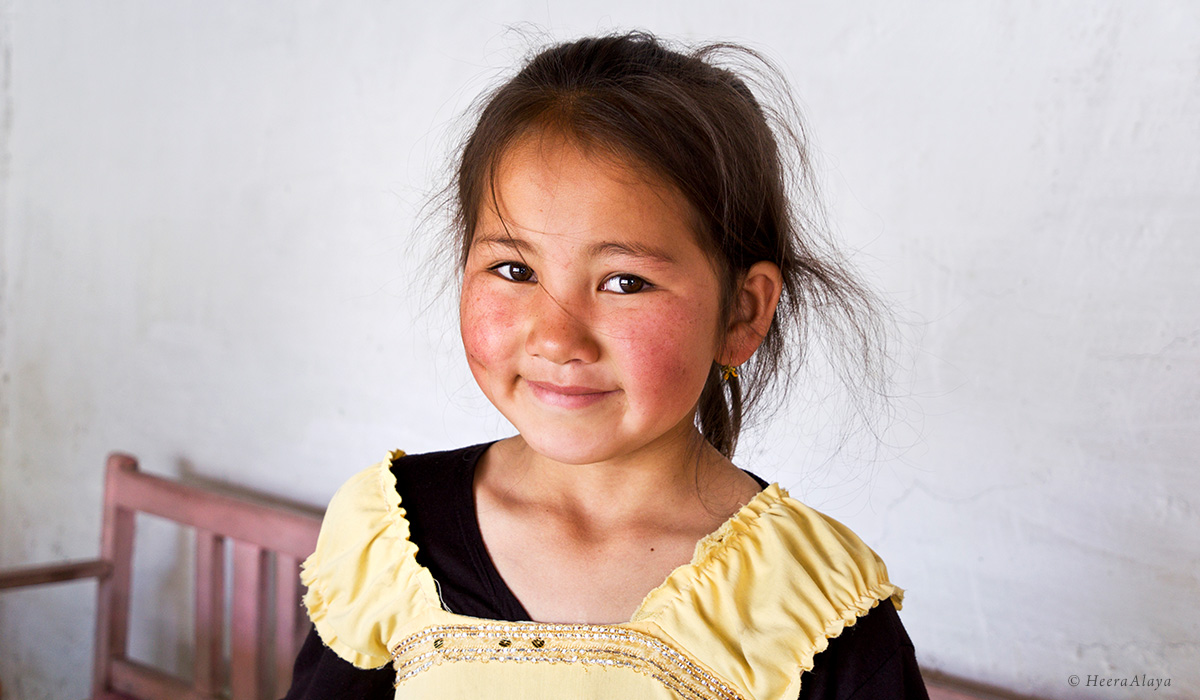
SLOW
INNOCENCE
untainted lives
By Heera Alaya
January 1st, 2021
The disfigured landscape, bearing signs of wear and tear, neglect, and men betraying their own, fails to conceal Kashmir’s staggeringly stunning terrains.
It was another one of those magical mornings captivated by the layers of nature’s magic. As often is the case, my guides were the light bouncing off mountains and the air infused with pine and cedar. I trekked, admiring the wildflowers with their sun-kissed faces, the nimble lambs grazing with sheep and the gleaming meandering streams. I didn’t expect life to present me with unexpected Mary Poppins moments—children rushing down the lush slopes towards me, showering me with unadulterated love.
The children’s intuitive embrace encouraged me to open up immediately. Amused, I even answered their volley of questions (and I thought I was curious!) charged with youthful exuberance. Surprisingly, these children, who were on a school picnic, wanted to be photographed; a few insisted on solos and retakes (I was pleasantly surprised to observe the outwardly shy be assertive.). This impromptu session, a gift of innocence, was an absolute delight.



Days later, while at a majestic garden—one I frequented as a child—the musical sounds of children squealing with joy added a welcome dimension to the blooming flowers and intricate stonework. The girls’ freeness and the boy’s bashfulness were a sight to behold. How wonderful childhood can be—to not have a care in the world and create joy with simple elements (that adults render useless)? I was tempted to join the children—to laugh, giggle and kick up sparkling beads of water.
The twinkle in the children’s eyes conveyed that though they live amid conflict and unrest, they were safe inside the four walls of their homes. In contrast to the girls’ freeness, one of their friends refused to join in the fun. This withdrawn child appeared to silently carry a massive story she couldn’t share with anyone. I couldn’t help but pick up on her pain. Where the other children had waved back at me, she didn’t; this child was quick to look away. I wondered if, unlike the everyday public life—dictated by checkpoints and surveillance—this child’s private life was the casualty of a different war—a heinous crime she couldn’t fight within the four walls of her home. I remain disturbed—feeling and thinking about the lifetime psychological and emotional ramifications of crimes against innocent, voiceless children. I know that unless children’s plight moves us and we question the worthwhileness of our lives, we cannot protect the innocence of childhood.



Further north, with omnipresent Buddhism, I experienced pure brotherhood. The tender, smiling faces of these young boys on the court instantly illuminated my soul. These innocent lives are reminders that the expressions of self, from childhood innocence, are governed, in addition to innate makeup, by factors such as emotional security, environment, playmates and caretakers. The monk teachers—who extended me their hospitality—support the boys gentleness.
I continued on my journey, holding the children’s innocence close to my heart, a balm for my soul.
The journey kept giving.

After a couple of days, during a monastery visit, a young novice monk’s (top centre) upbeat spirit caught my attention; I wanted to photograph him along with his two friends. The child monk suggested the spots and, once done with pictures, came closer and whispered: “200 rupees.” This resourceful lad then nudged his friends to follow suit; they were hesitant. Chances are, our young monk took a commission from his friends. Talk about being enterprising!
A while later, our monk friend popped up around the corner, alone, minus his cap, offering: “500 rupees, one photo!” As with almost every uniform, the child monks in maroon robes looked identical, so I wasn’t sure if it was the same child monk, but the impish smile on his cute face confirmed my doubts. Kneeling, I asked if he was the same child who posed with his friends earlier; he nodded sheepishly (He did get a tip for his innovative thinking—removing his cap to alter his appearance.). I don’t remember the last time I laughed that hard; my stomach hurt.

During another experience at a different monastery—where I sat amid Buddhist children and monks during their prayers—a young girl (the child wearing pink shoes) glanced at me from time to time, throwing me a hint of a smile. Grateful for this girl’s acknowledgement, I reciprocated. After the long prayer meeting, I asked this lovely child if she would be so kind as to let me take a few pictures; she agreed, tugging along her shy friend and touching her reassuringly. This momentary interaction beautifully showcased this confident child’s inclusiveness (she had earlier demonstrated the same to me, subtly) and support of her friend, which speaks to genuine, nurturing friendships that naturally encourage, include and guide.
This authentic welcome—of making you feel at home and included—is what I felt again en route as I passed ceaseless sculpted mountains to my next destination. I engaged with children playing on the road during a refreshment stop and invited them to join me. These pure souls filled my heart with song, dance, and silliness as one would with a familiar person. In situations like these—where I chance upon contented children displaying a total lack of pretence—I always think how fortunate they are to have a childhood, unlike city-bred children. The latter is stripped of childhood, programmed to be pretentious and greedy, and made spiritually impoverished.



Throughout my mostly unscripted spiritual journey, I naturally met children and experienced a spectrum of emotions and behaviours—from vitality to fellowship to spontaneity. These children reminded me that they hear with their hearts and talk with their eyes. The beautiful thing about childhood (for those cherished and protected by caretakers) is that children aren’t tainted with adult-acquired prejudices. How can it not be our collective responsibility to preserve innocence?




